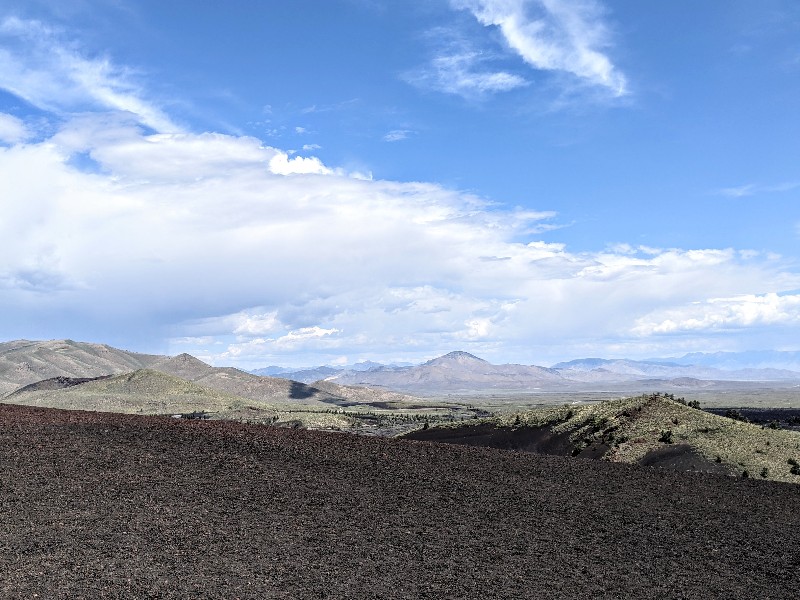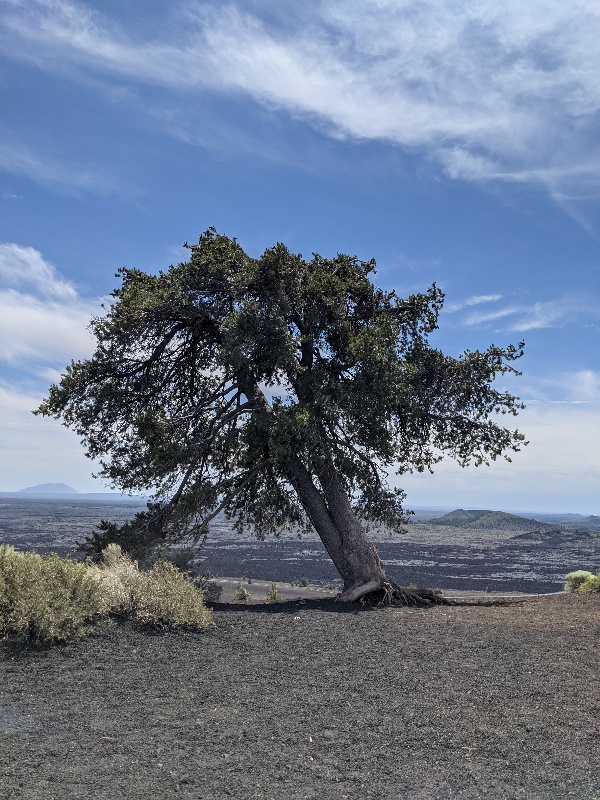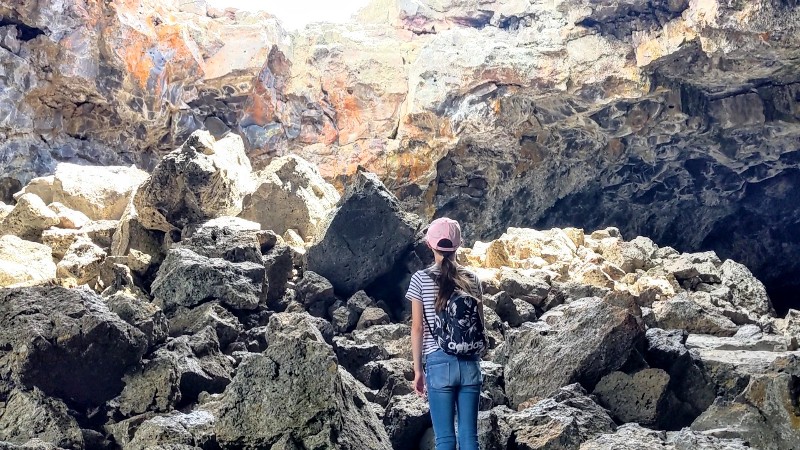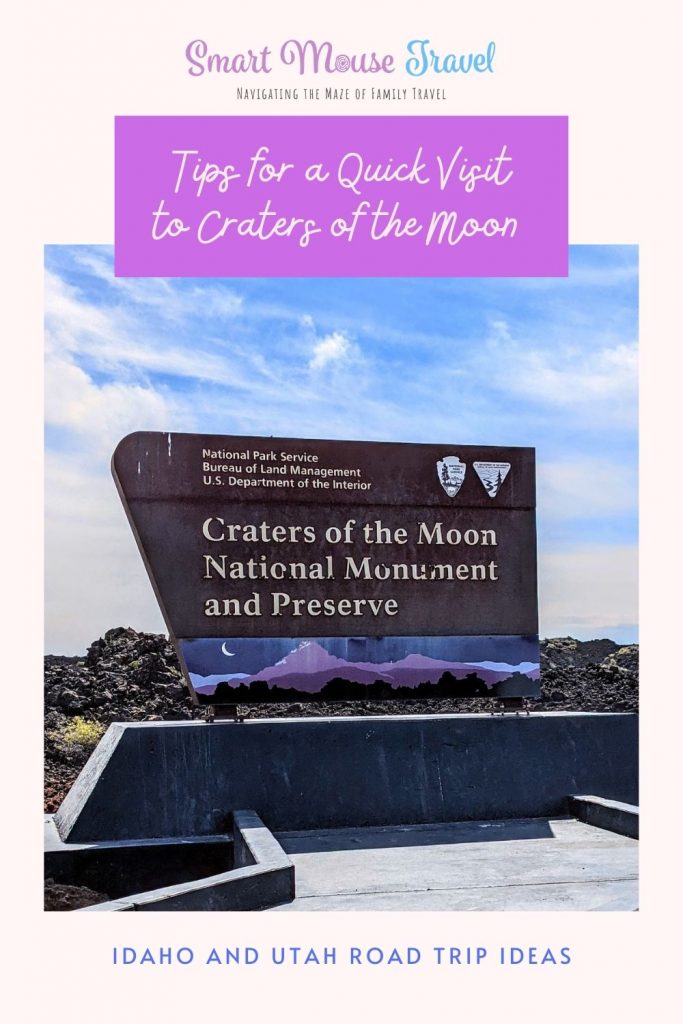Craters of the Moon National Monument and Preserve in Idaho is one of the most unique national parks we have visited. Formed by molten lava long ago, Craters of the Moon is a landscape of black rocks, gnarly trees, and dots of persistent flowers growing in the cinders during summertime. Make the most of a quick visit to Craters of the Moon National Monument with these tips.
Where is Craters of the Moon National Monument and Preserve?

Craters of the Moon National Monument is located 90 minutes from Sun Valley, Idaho or just shy of 4 hours from Salt Lake City, Utah. This remote location means most people only have a short time to visit while road tripping through the area.
How Much Time Should I Budget for Craters of the Moon?
Two hours at Craters of the Moon gives a good overview of the park and its unique terrain. You can easily add or remove from our itinerary to best suit your available time at the park.
The Best of Craters of the Moon National Monument and Preserve in 2 Hours
Begin At The Visitor Center
Start your Craters of the Moon National Monument visit at Robert Limbert Visitor Center. The small visitor center has a tiny gift shop and overview of how the park was formed from lava eruptions over 2000 years ago. Grab a park map and free cave permit before starting on the loop road.
After leaving the visitor center begin your tour on the well marked loop road. Most sights and trailheads at Craters of the Moon are easily accessible from the loop road. There are also several pull-offs with informational signs along the road.
Inferno Cone Trail

A short, but steep, 0.2-mile hike takes you to the top of Inferno Cone. This trail is made of black cinder and can be a little tricky to navigate on the way up without hiking shoes.
After reaching the top of the trail, admire breathtaking views and the tenacious plants strong enough to grow on this inhospitable terrain.
Spatter Cones

From Inferno Cone it is a short drive on the loop road to Spatter Cones. This time a short, paved hike transports you to the top of a mini volcano. These spatter cones once spewed the lava that helped form the park.
Indian Tunnel
Spatter cones are only one way lava flowed to form Craters of the Moon. Lava tubes are another fascinating formation to explore. Lava tubes were formed as the top lava layer hardened, but molten lava continued to flow underneath.
To hike into lava tubes, or caves, you must get a free cave permit from the visitor center. There are four different lava tube caves available from one main trail head. A large parking lot provides access to the hiking trails for Dewdrop, Beauty, Boy Scout, and Indian Tunnel.
The most popular of the lava tube caves is Indian Tunnel. The roughly one-mile hike in each direction leads to a set of stairs which descend into a large lava tube formerly used by Native Americans.
Descending down into to the tunnels I was surprised that the stairs ended quickly on a rocky platform. The rest of the trail was completely natural, made of rocks and hardened lava.
Two parts of the rocky canopy have collapsed, leaving piles of rocks to scramble up and admire the sunlight streaming in. We were glad to have our hiking shoes in this uneven terrain.

Several areas of Indian Tunnel are very dark, so use a flashlight to avoid tripping on uneven ground or loose rocks. Exploring Indian Tunnel was our favorite Craters of the Moon National Monument activity.
If you only have time to do one thing I highly recommend hiking to Indian Tunnel at Craters of the Moon. The hike showcases the hardened lava landscape and Indian Tunnel was fun to explore.
New to hiking? Here are some of our best beginner hiking tips.
Tips for Visiting Craters of the Moon
Set GPS to Robert Limbert Visitor Center
When looking up directions set your destination as Robert Limbert Visitor Center. Some GPS will send you out into the middle of nowhere if you set Craters of the Moon National Park as your destination.
Don’t Wear Items From Other Cave Visits
Caves are fragile ecosystems and diseases from other caves can live on shoes for years. Craters of the Moon will not issue cave permits to anyone wearing shoes that have been in another cave in the last 15 years.
Make sure you have new shoes, or a set not previously worn in a cave, to experience Indian Tunnel and other caves on-site.
Pack Food and Water
Craters of the Moon National Park is really isolated, even more than other national parks we’ve visited. The visitor center has a couple vending machines, but no dining on-site or nearby. Pack a picnic or at least some heavy snacks before visiting.
Bring Money or Your America the Beautiful Pass
Craters of the Moon charges admission or you can use an America the Beautiful Pass. Only Robert Limbert Visitor Center is available without paying a fee.
There is Limited Mobile Phone Service
Inside Craters of the Moon we had limited, or no, phone service. Stop by the visitor center and use the WiFi to get directions to your next destination if you find yourself without a phone signal.
Final Thoughts On Quick Visits To Craters of the Moon National Park
Although off the beaten path, Craters of the Moon is worth a quick visit if you are in the area on a road trip or as a day trip from Sun Valley. We were able to explore much of the park during our two hour visit and it was worth the slight detour on our road trip to see the unusual landscape and explore Indian Tunnel.
Pin it for later:

